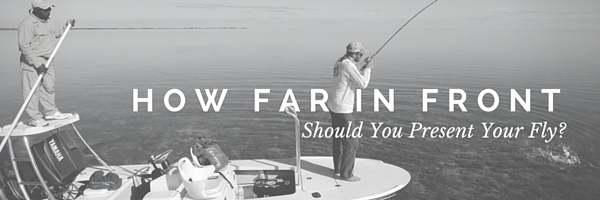Whether you’re a new or seasoned angler, there are a number of factors to consider when deciding how far you should lead your fly. No single, lead distance will work well in every situation. If you ask around, you’ll hear stories of success that involve leads of up to three feet and leads as short as a few inches. The key to leading a bonefish correctly lies in understanding the different factors that can impact your success.
Stealth
The importance of stealth simply cannot be overstated. Slapping the line on the water’s surface just above a fish could send him darting away. You also have to consider the fact that bonefish stay on the move. The best way to avoid lining a fish is to present the fly at a distance that accounts for potential movement.
Get In The Zone
Practice and experience will make you more adept at leading the fly at the perfect distance for every situation. As a general rule, however, presenting the fly just between one and three feet of a moving bonefish will usually put you in a safe zone. Factors such as wind speed, wind direction and even the speed of the bonefish will invariably impact the efficacy of your cast and the lead distance.
Lead Less For A Slow Moving Fish
To accurately account for movement, you’ll need to shorten or lengthen the distance of your lead according to how fast the fish is moving. If the fish is moving slow, go for a fairly short lead that’s closer to one foot ahead of the bone rather than three. If the fish is moving fast, lead by three feet or even consider spreading out to four.
Your Fly Weight
Bonefish glean most of their food from the flat bottom. This means that you also have to lead out far enough to give your fly weight ample opportunity to hit the bottom and start mimicking the movements of a realistic-looking meal. With a lighter fly weight, you should cast a bit further out and lead at a greater distance. Water depth is additionally important. Fly weights won’t have far to sink in shallow water and thus, they won’t take very long to drop even if they’re very light.
Gauging The Attitude And Behavior Of Bonefish
A tailing bonefish is believed to be a happy one and a tailing bone is also a lot less likely to spook. Try dropping your fly as close as you possibly can to these in order to elicit an immediate strike. With a bone that’s simply cruising around the flat bottom, lazily looking for food, go for a two to three foot lead distance. This is when you want to have plenty of opportunity for your fly to hit the bottom so you don’t spook the bone away.
Go For A Close Lead With The Big Ones
Big bones have survived by being smart. You don’t want to give a larger and more savvy fish time to inspect your fly. When you spot a bonefish that’s easily in the double-digits, try to land your fly a lot closer than you normally would and hope for an immediate and instinctive reaction. While an average-sized fish will usually respond to a two to three foot lead, big bones aren’t often lured in via this approach.
Let The Weather Be Your Guide
Weather conditions will dictate much of your actions while out in the flats. When the sky is clear and sunny, lead out further. A delicate approach is often essential on these days if you don’t want to scare the fish away. Breezy days with cloud cover and lower natural light tend to make bones a bit less careful. At these times, you can lead closer and land your fly tighter. In either instance, your fly should still have plenty of time to sink to the bottom.









